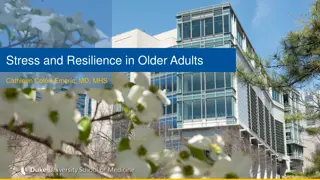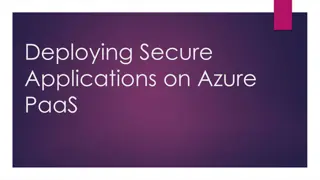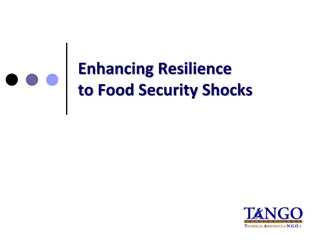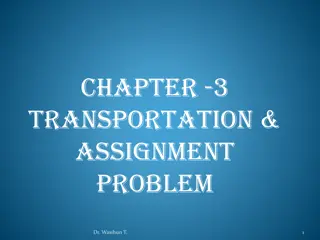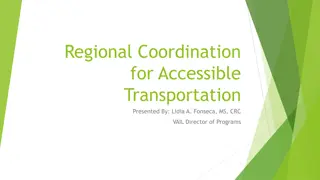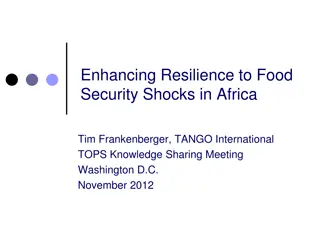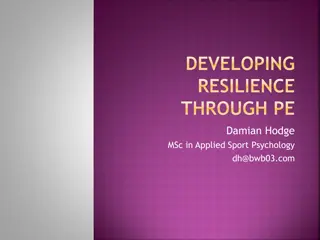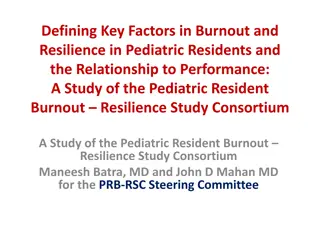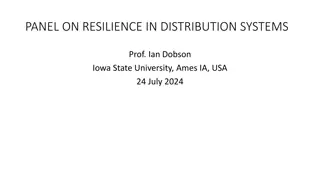Deploying Transportation Resilience Practices: Tools and Insights
Develop tools for fostering a resilience-focused culture in state DOTs through literature review, case studies, and feedback. Explore various definitions of resilience, including organizational perspective, and key observations from the Transportation Resilience Innovations Summit. Emphasize the importance of incorporating resilience considerations across all functional areas of DOTs.
- Transportation Resilience
- State DOTs
- Organizational Perspective
- Resilience Tools
- Infrastructure Dependencies
Download Presentation

Please find below an Image/Link to download the presentation.
The content on the website is provided AS IS for your information and personal use only. It may not be sold, licensed, or shared on other websites without obtaining consent from the author. Download presentation by click this link. If you encounter any issues during the download, it is possible that the publisher has removed the file from their server.
E N D
Presentation Transcript
NCHRP 20-117: DEPLOYING TRANSPORTATION RESILIENCE PRACTICES IN STATE DOTS Purpose: Develop a set of tools and products for agencies interested in achieving a resilience-focused culture in their organizations. Products resulted from: Literature review Feedback from conference sessions on interim products Case studies Resilience Innovations Summit and Exchange (RISE)
MANY DEFINITIONS OF RESILIENCE Transportation systems resilience Transportation operational resilience DOT organizational resilience
MANY DEFINITIONS OF RESILIENCE The Concept The ability to prepare and plan for, absorb, recover from, or more successfully adapt to adverse events. ---The National Academies 2012
MANY DEFINITIONS OF RESILIENCE Organizational Perspective An organization that examines all organizational functions from the perspective of current status and that identifies actions to enhance organizational capacity. The concept of risk management has been integrated throughout all levels of the DOT such that priorities can be established to minimize the impacts and consequences of transportation system disruption.
TRANSPORTATION RESILIENCE INNOVATIONS SUMMIT AND EXCHANGE (RISE) Three themes: Enhancing an Organization s Capacity for Incorporating Resilience into Its Activities Recognizing Infrastructure Dependencies and Fostering Partnerships Making the Case for Resilience Co-sponsored by AASHTO, FHWA, TRB, and the Colorado Department of Transportation Over 450 participants State DOT poster session
KEY OBSERVATIONS FROM RISE Transportation system resilience a concern for all transportation agencies and their partners. Starts with agency leadership. Most experience planning and implementing emergency response procedures. All functional units within a transportation agency have roles.
RESILIENCE CONSIDERATIONS SHOULD BE PART OF ALL DOT FUNCTIONAL AREAS Society in general Environmental systems Economic systems Other infrastructure support systems Political and governmental systems Social systems
KEY LESSONS / OBSERVATIONS FROM RESILIENCE INNOVATIONS SUMMIT AND EXCHANGE (RISE) Key Incorporating resilience concerns into decision-making processes. Transportation planning is where it should start. Consequences greater impacts on disadvantaged populations. Need for developing information, tools, and data to make the case for resilience.
KEY LESSONS / OBSERVATIONS FROM RESILIENCE INNOVATIONS SUMMIT AND EXCHANGE (RISE) Analysis frameworks exist and are being used. Sharing best practices. Training and professional development. Focus what transportation systems enable. Transportation agencies cannot do it alone.
MAINSTREAMING SYSTEM RESILIENCE CONCEPTS INTO TRANSPORTATION AGENCIES: A GUIDEBOOK Self-assessment Tool Human-caused (e.g., cyberattacks) and natural disruptions (e.g., large- scale flooding). Hazards that occur today as well as those that will likely occur in the future. Hazards that occur persistently as well as those that might occur once- in-a-lifetime. Thus different analysis and data collection might be necessary.
MAINSTREAMING SYSTEM RESILIENCE CONCEPTS INTO TRANSPORTATION AGENCIES: A GUIDEBOOK Every functional area within a DOT with a role in making the transportation system more resilient. Participation of many different agencies, organizations, communities, and groups that leads to multi-disciplinary collaborative efforts. Broad definition of benefits, costs, and impacts Community resilience, economic, and social impacts, and in a broad sense, quality of life.
BASED ON CAPABILITY MATURITY MODEL CONCEPT Maturation Factors Maturity Level 3 Maturation Factors Maturity Level 2 Maturity Level 1
RESILIENCE ASSESSMENT FRAMEWORK Step 1: Assess Current Practice Step 2: Organize for Success Step 3: Develop an External Communications Strategy and Plan Step 4: Implement Early Wins Step 5: Understand the Hazards and Threats
RESILIENCE ASSESSMENT FRAMEWORK Step 6: Understand the Impacts Step 7: Determine Vulnerability/Risk and Prioritize Step 8: Identify Actions to Enhance Resilience Emergency Response Capabilities and Agency Preparedness Operations and Maintenance Detailed Assessments of Exposed Assets and New Projects Asset Management
RESILIENCE ASSESSMENT FRAMEWORK Step 9: Program and Implement Resilience Measures Step 10: Monitor and Manage System Performance Overall Agency Score and Scores for Individual Steps
EXAMPLE STEP ASSESSMENT Level 1 (1 point) Level 2 (2 points) Level 3 (3 points) Maturity Factor Has your agency undertaken a systematic effort to identify those actions that could be implemented quickly and that would enhance system resilience? Has your agency adopted a policy where new projects are to explicitly consider resilience in terms of design and operations? We have informally identified where early win improvements can be made. The responsibility for implementing rests with the respective functional units. No written documentation has yet been produced. We have undertaken a systematic assessment for (up to) two of our agency s units. Written reports have been prepared that indicates the recommended steps and how they will be implemented. We have undertaken a systematic assessment for all our agency s units. A written report has been produced that is available for both agency staff and for stakeholders to understand the need and purpose for implementing the recommended actions. Only major projects (e.g., over a certain estimated cost) consider resilience in their design. The assessment considers only historical and current hazards and threats. Only major projects consider resilience in their design. The assessment considers both historical/current and future hazards and threats. All new projects consider resilience to current and future hazard and threats.
SCORING Score Range Description of Agency Maturity in Implementing Early Wins Your agency is emerging into this area and has taken initial steps to grow awareness and understanding of the types of early wins it can implement. 0 to 12 Your agency has implemented several early win strategies, not so much as part of an agency-wide strategy but rather at the initiative of agency staff. 13 to 23 Your agency has reached significant maturity in identifying and implementing an early wins strategy. Major focus should be on maintaining and enhancing existing efforts when appropriate and taking advantage of new opportunities as they become available. 24 to 27
RECOMMENDED ACTIONS Responsibility Timeframe? outcomes? Expected Let s do this (check) Action ? Undertake a systematic effort/study to identify early wins to enhance system resilience. Assign staff responsibilities and/or establish an organizational mechanism for identifying early wins to enhance resilience efforts. Develop agreements or understandings with FEMA on procedures and requirements when a disaster has been declared.
RECOMMENDED ACTIONS FOR: leadership and management Planning Project development/engineering System and traffic operations Construction Policy development/agency Maintenance Asset management Emergency response/agency preparedness Public outreach/communications
GUIDEBOOK THEMES Collaboration Communication Data collection and analysis Hazard and threat assessment Institutional capacity Leadership Professional training and professional development
THOUGHTS ON NATIONAL RESILIENCE PROGRAM Analogy Traffic Incident Management Coalition (NTIMC) National Unified Goal (NUG) and National 26 national organizations Adopted strategic goals Six cross-cutting strategies
NTIMC CROSS-CUTTING STRATEGIES Partnerships and programs Multidisciplinary training Goals for performance and progress webinars Technology Awareness and education partnerships Very similar for a Resilience Program
IMPLEMENTATION OF RESEARCH RESULTS Peer exchanges Pilot studies on use of the Guidebook Presentation at conferences and annual meetings. Webinars Information dissemination to target audiences.
FOCUS ON EDUCATIONAL PROGRAMS Undergraduate Courses Course lecture modules Undergraduate capstone experience Graduate Courses Course lecture modules System resilience course
FOCUS ON DOT TRAINING: TOPICS What is Transportation System Resilience and How Does It Affect My Agency? Adaptive Project Development and Design (note: NHI is currently developing a course on this topic) Incorporating Risk into Project Decision-Making Community Resilience and Where Does Transportation Fit In? System Resilience and Transportation Planning
FOCUS ON DOT TRAINING: TOPICS System Resilience and System Operations System Resilience and Maintenance System Resilience and Asset Management Communicating Resilience Concepts to the Public
CONCLUDING OBSERVATIONS In addition to the observations from RISE ---- Considering risk and system resilience Funding resilience projects and/or resilience-oriented project add-ons Coordinating with other states Finding resilience champions
CONCLUDING OBSERVATIONS Considering network cascading effects and telecommunications system of systems Considering disadvantaged populations Big wins, but also small victories add up to a significant change




